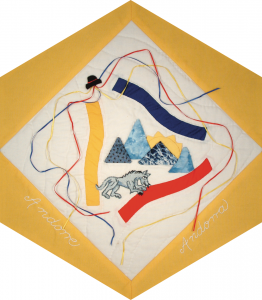Andorra

The Block
The rugged landscape of Andorra, where steep mountain peaks tower over three deep valleys and gorges carved out by glaciers, is depicted through appliqué done by Pat Brittain. Situated below the hills is a wolf-like beast, embroidered by Bernice Michaud. The creature is a replication of a 12th century painting found in a Romanesque bestiary in the church of La Cortinada.
Three quilted, cotton strips in the colours of the Andorran flag surround this representation of Andorra. Colourful streamers flow from a black hat, symbolizing the importance of folk dances in Andorran culture, and evoking memories of the Ball de la Marratxa, performed during the Village Festival in Sant Julià. On this day, two men wearing top hats ornamented with multicoloured ribbons, dance together with three ladies each. It is believed by many that this dance represents the nation’s two co-princes dancing with the original six parishes which made up the country.
Cultural Profile
Located high in the Pyrenees between France and Spain, Andorra is one of the oldest, highest, most isolated and smallest countries in the world. It is so small, in fact, that you could drive across it in less than one hour. The official language is Catalan, although French and Spanish are also spoken, as the population is comprised of Native Andorrans, Spanish, French and Portuguese nationals.
For more than 700 years, France and Spain governed Andorra jointly. This unusual balance of power allowed the nation to remain an autonomous principality and not be annexed by one of its large neighbours. It also helped Andorra to stay neutral despite recurring tension between the co-princes.
Historically Andorrans were farmers, woodcutters and shepherds, but as international tourism boomed in the 1950s, the country became increasingly modern and achieved considerable prosperity. Over ten million people now visit Andorra each year, attracted by magnificent scenery, local architecture, folklore, and huge snowfalls (called ‘white gold’ by Andorrans) that provide some of the world’s best skiing.
While some ways of life have changed, the average Andorran’s life is still centered on the family. Festivals remain an important aspect of Andorran culture. Dancing and celebrations take place in the streets during national festivals like Constitution day, in March, or Day of Our Lady of Meritxell, in September. Many festivals also feature a medieval heroine known as ‘The White Lady.’ National crafts include musicatore, (beautifully made and decorated pine furniture), metal kitchen utensils and leather goods intricately carved with the sharp point of a knife.
Although Andorrans have been coming to Canada since 1969, the Andorran community in this country remains very small.
Sponsor: Permanent Mission of the Principality of Andorra to the United Nations
